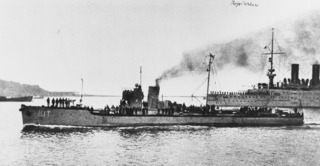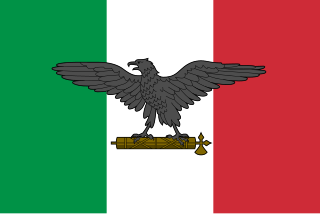Related Research Articles

HMS Jervis, was a J-class destroyer of the Royal Navy named after Admiral John Jervis (1735–1823). She was laid down by R. and W. Hawthorn, Leslie and Company, Limited, at Hebburn-on-Tyne on 26 August 1937. The ship was launched on 9 September 1938 and commissioned on 8 May 1939, four months before the start of the Second World War.

The Battle of the Mediterranean was the name given to the naval campaign fought in the Mediterranean Sea during World War II, from 10 June 1940 to 2 May 1945.
At the outbreak of the Second World War Nazi Germany's Kriegsmarine had 21 destroyers in service, while another one was just being completed. These 22 vessels – comprising 3 classes – had all been built in the 1930s, making them modern vessels. Including that final pre-war vessel, a further 19 were brought into service during the war and more were captured from opposing navies, including the Italian Navy after the Italian Armistice with the Allies in 1943.
The Ariete-class torpedo boats were a group of destroyer escorts built for the Italian Navy during World War II. They were enlarged versions of the Spica-class torpedo boats and designed to escort convoys to North Africa. Of the 42 units planned, sixteen ships were eventually ordered but only one was completed by the time of the armistice, Ariete, built in the Sestri Ponente shipyards and commissioned on 5 August 1943. The namesake ship was also the only one to survive the war. After the war it was ceded to the Yugoslav Navy (1949), and renamed Durmitor.

Dubrovnik was a flotilla leader built for the Royal Yugoslav Navy by Yarrow Shipbuilders in Glasgow in 1930 and 1931. She was one of the largest destroyers of her time. Resembling contemporary British designs, Dubrovnik was a fast ship with a main armament of four Czechoslovak-built Škoda 140 mm (5.5 in) guns in single mounts. She was intended to be the first of three flotilla leaders built for Yugoslavia, but was the only one completed. During her service with the Royal Yugoslav Navy, Dubrovnik undertook several peacetime cruises through the Mediterranean, the Turkish Straits and the Black Sea. In October 1934, she conveyed King Alexander to France for a state visit, and carried his body back to Yugoslavia following his assassination in Marseille.

The Beograd class of destroyers consisted of three ships built for the Yugoslav Royal Navy in the late 1930s, a variant of the French Bourrasque class. Beograd was constructed in France and Zagreb and Ljubljana were built in the Kingdom of Yugoslavia. In January 1940, Ljubljana struck a reef off the port of Šibenik, and was still under repair when the German-led Axis invasion of Yugoslavia commenced in April 1941. During the invasion, Zagreb was scuttled to prevent its capture, and the other two ships were captured by the Italians. The Royal Italian Navy operated Beograd and Ljubljana as convoy escorts between Italy, the Aegean Sea, and North Africa, under the names Sebenico and Lubiana respectively. Lubiana was lost in the Gulf of Tunis in April 1943; Sebenico was seized by the Germans in September 1943 after the Italian surrender and was subsequently operated by the German Navy as TA43. There are conflicting reports about the fate of TA43, but it was lost in the final weeks of the war.

The Navy of the Independent State of Croatia, was the navy of the Independent State of Croatia, an Axis puppet state controlled by the fascist Ustaše party. The NDH was created from parts of the Kingdom of Yugoslavia on 10 April 1941, four days after the World War II invasion of Yugoslavia by the Axis powers commenced. The RMNDH consisted of two commands, the Coast and Maritime Traffic Command, and the River and River Traffic Command, and had its headquarters in the NDH capital, Zagreb. The Coast and Maritime Traffic Command consisted of three naval commands along the Adriatic coast, which were each divided into a number of naval districts. The naval districts consisted mainly of naval and weather stations, and were only responsible for coast guard and customs duties. The River and River Traffic Command consisted of seven river stations, a naval infantry battalion, and a River Command Flotilla built around two former Yugoslav river monitors, which had been scuttled during the invasion but subsequently refloated.

T3 was a sea-going torpedo boat that was operated by the Royal Yugoslav Navy between 1921 and 1941. Originally 78 T, a 250t-class torpedo boat of the Austro-Hungarian Navy built in 1914, she was armed with two 66 mm (2.6 in) guns, four 450 mm (17.7 in) torpedo tubes, and could carry 10–12 naval mines. She saw active service during World War I, performing convoy, escort and minesweeping tasks, anti-submarine operations and shore bombardment missions. Following Austria-Hungary's defeat in 1918, she was allocated to the Navy of the Kingdom of Serbs, Croats and Slovenes, which subsequently became the Royal Yugoslav Navy, and was renamed T3. At the time, she and the seven other 250t-class boats were the only modern sea-going vessels of the fledgling maritime force.

The Palestro-class were four destroyers of the Italian Regia Marina that saw service from the mid-1920s to World War II.

The Adriatic campaign of World War II was a minor naval campaign fought during World War II between the Greek, Yugoslavian and Italian navies, the Kriegsmarine, and the Mediterranean squadrons of the United Kingdom, France, and the Yugoslav Partisan naval forces. Considered a somewhat insignificant part of the naval warfare in World War II, it nonetheless saw interesting developments, given the specificity of the Dalmatian coastline.
The La Melpomène class was a group of 12 French torpedo boats built from 1933 to 1935.

The Battle of the Ligurian Sea was a naval surface action of the Second World War fought on 18 March 1945, in the Gulf of Genoa in the Mediterranean Sea. A Kriegsmarine flotilla of two torpedo boats and one destroyer was conducting an offensive mine laying operation at night when it was intercepted by two Royal Navy destroyers; HMS Lookout and Meteor. The British destroyers sank two of the German ships and severely damaged the third; it was the last German naval surface action of the war.
The action of 1 November 1944, also known as the Ambush off Pag Island, was a naval engagement in the Kvarner Gulf of the Adriatic Sea, between the islands of Pag and Lussino on 1 November 1944. It was fought between a British Royal Navy destroyer flotilla and a Kriegsmarine force of two corvettes and a destroyer. The German flotilla was deployed to escort a convoy retreating from Šibenik to Fiume. The British managed to destroy all three German ships in return for no loss.

Beograd was the lead ship of her class of destroyers, built for the Royal Yugoslav Navy during the late 1930s, and designed to be deployed as part of a division led by the flotilla leader Dubrovnik. She entered service in April 1939, was armed with a main battery of four 120 mm (4.7 in) guns in single mounts, and had a top speed of 35 knots.

The 250t class were high-seas torpedo boats built for the Austro-Hungarian Navy between 1913 and 1916. A total of 27 boats were built by three shipbuilding companies, with the letter after the boat number indicating the manufacturer. There were small variations between manufacturers, mainly in the steam turbines used, and whether they had one or two funnels. The eight boats of the T-group, designated 74 T – 81 T, were built by Stabilimento Tecnico Triestino, located at Trieste. The sixteen boats of the F-group, 82 F – 97 F, were built by Ganz-Danubius at their shipyards at Fiume and Porto Re. The three M-group boats, 98 M – 100 M, were manufactured by Cantiere Navale Triestino at Monfalcone.

The National Republican Navy was the navy of the Italian Social Republic, a World War II German puppet state in Italy.
The German torpedo boat TA37 was an Ariete-class torpedo boat operated by the German Kriegsmarine during the Second World War. The ship was built for the Italian Navy by the shipbuilder CRDA at their Trieste shipyard with the name Gladio in 1943, but was incomplete when Italy surrendered to the Allies in September 1943, and was seized by Nazi Germany. The ship entered service as TA37 in 1944, serving in the Adriatic and Aegean seas and was sunk by British destroyers on 7 October 1944.
The German torpedo boat TA24 was an Ariete-class torpedo boat operated by the German Kriegsmarine during the Second World War. The ship was built for the Italian Navy by the shipbuilder Ansaldo at their Genoa shipyard with the name Arturo in 1943, but was incomplete when Italy surrendered to the Allies in September 1943, and was seized by Nazi Germany. The ship entered service as TA24 in October 1943, serving in the Tyrrhenian Sea and was sunk by British destroyers on 18 March 1945.
References
- Gröner, Erich (1990). German Warships 1815–1945. Vol. 1: Major Surface Warships. Annapolis, Maryland: Naval Institute Press. ISBN 0-87021-790-9.
- Rohwer, Jürgen (2005). Chronology of the War at Sea 1939–1945: The Naval History of World War Two (Third Revised ed.). Annapolis, Maryland: Naval Institute Press. ISBN 1-59114-119-2.
- Sieche, Erwin (1980). "Germany". In Chesneau, Roger (ed.). Conway's All the World's Fighting Ships 1922–1946. London: Conway Maritime Press. ISBN 0-85177-146-7.
- Whitley, M. J. (2000). Destroyers of World War Two: An International Encyclopedia. London: Cassell & Co. ISBN 1-85409-521-8.
- Whitley, M. J. (1991). German Destroyers of World War Two. Annapolis, Maryland: Naval Institute Press. ISBN 1-55750-302-8.